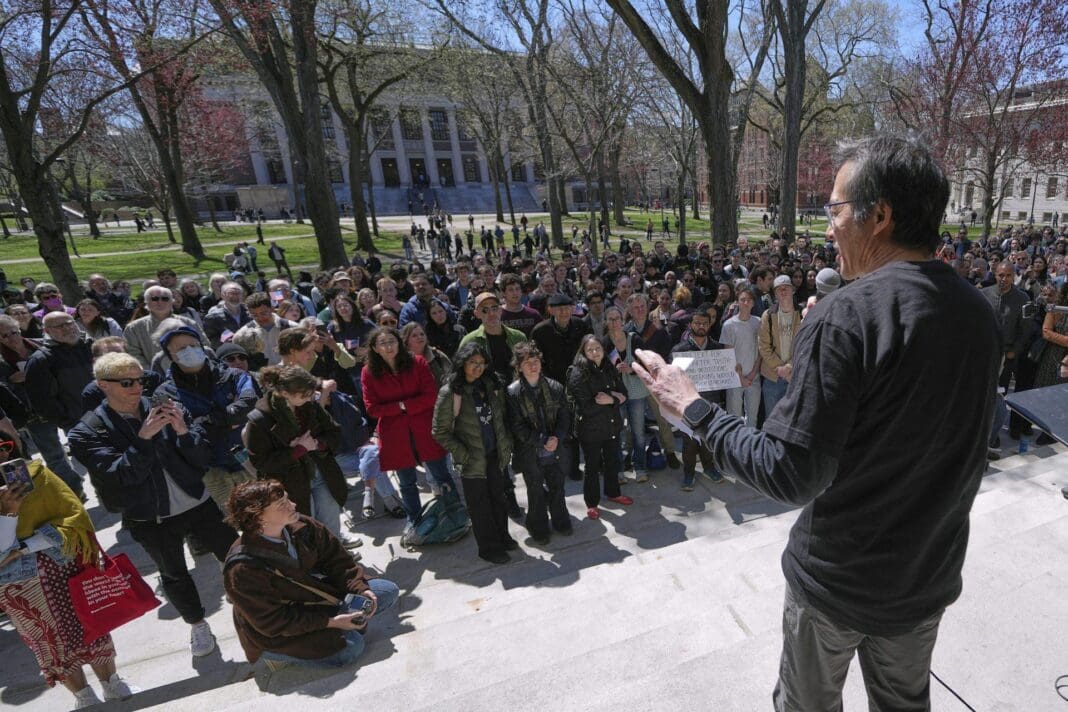The Trump administration is demanding that at least 60 U.S. colleges and universities change their policies or lose out on billions of dollars in federal funding.
In Harvard University’s case, the government has accused the Ivy league school – so far without providing any specific evidence – of violating some students’ civil rights by allowing other students to engage in what the authorities characterize as antisemitic speech. The government has demanded broad oversight of Harvard’s admissions policies, along with changes in its hiring processes and campus culture.
Harvard stands to lose out on more than US$2.2 billion. It may seem to be better insulated from this pressure than many other schools because it has the nation’s largest educational endowment – a reservoir of stocks, bonds and other financial assets that helps fund its operations, research and scholarships. Harvard’s endowment totaled more than $53 billion in 2024.
As a nonprofit law scholar, who served in the Treasury Department’s Office of Tax Policy in the 1980s, I study and write about both state and federal law as it applies to nonprofit organizations. I believe that the law permits most colleges and universities to increase spending from their endowments in light of the financial pressures so many of them are facing.
Not all endowments are alike.
They tend to be composed of an array of smaller funds, some of which are subject to legal restrictions that make it impossible for the schools they support to freely use those assets.
Universities must respect the limits donors put on their gifts, such as tying them to specific scholarships, funding jobs held by certain kinds of professors or supporting the construction or maintenance of a particular building.
It’s up to a university’s governing board to decide how much of the school’s endowment will be spent in a given year.
As Harvard’s financial report for its 2024 fiscal year puts it: “There is a common misconception that endowments, including Harvard’s, can easily be accessed like checking accounts.” That is definitely not the case.
Nonetheless, some college and university boards did allow increased endowment spending at the height of the COVID-19 pandemic and the Great Recession, which lasted from late 2007 until mid-2009.
During that downturn and the financial crisis that precipitated it, the value of endowments, along with most financial assets, plummeted.
About 80% of Harvard’s 14,000 separate endowment funds are reserved for “specific programs, departments or purposes.” But others are less restricted, Harvard has stated in the financial reports it makes available to the public.
While it’s always important to proceed with care when spending money reserved for use on a rainy day or to ensure the long-term existence of a revered institution, most colleges and universities are freer to dip into their endowments than they may realize when conditions get stormy.
In all states except Pennsylvania, U.S. endowments are subject to a 2006 model law known as the Uniform Prudent Management of Institutional Funds Act.
Under this law, managing and investing an endowment requires the university to consider its charitable purposes and financial needs, while respecting the intentions of the donors who provided its assets. These are state laws, not federal statutes. In most states, a university may spend as much of an endowment fund as it deems “prudent.”
Exercising that prudence requires the consideration of several factors.
They include the purposes of the institution as a whole and the particular endowment fund, prevailing economic conditions, and what other financial resources the institution can tap. However, in almost one-third of states, including California and New York, annually spending more than 7% of an endowment’s fair market value, measured by a three-year average, is presumed to be imprudent.
But that isn’t a legal maximum because the model law’s drafters noted that “circumstances in a particular year” could easily void that presumption. Based on my study of nonprofit law, including the laws that apply to higher education, I’m confident that this caveat could easily apply to the Trump administration’s education-related spending cuts in 2025, just as it did during the pandemic and the Great Recession.
What’s more, endowment spending rate by universities in 2024 was 4.8%. As a result, many universities, including those in states with a 7% cap on prudent spending, will likely be able to increase their use of endowment funds to maintain their budgets at prior levels.
In addition, living donors can release any restriction they placed on the funds they gave universities that are still held in their endowments. Even when those funds are from donors who have died, a university can ask a court to release restrictions that have become impractical or wasteful.
The Uniform Prudent Management of Institutional Funds Act also permits institutions to lift restrictions on all endowment funds that are more than 20 years old and relatively small. This amount varies from state to state and typically ranges between $25,000 and $100,000
In addition to Harvard, other examples of the largest higher education endowments include Yale with $41 billion, Princeton with $34 billion and Columbia, which has some $15 billion. All three are among the 60 schools the Education Department is investigating for allegedly failing to “protect Jewish students on campus.”
Why do the boards of even these universities tend to hesitate to dip deeply into their endowments when their revenue declines?
One explanation is that because endowments can enhance a university’s prestige, its leaders and endowment donors have a bias toward accumulating rather than spending. Another is that board members have an obligation to protect their institutions’ long-term viability. Boards also bear a responsibility to preserve funds for a future rainy day, no matter how severe the current turbulence may be, how large the endowment has become or how successful the school’s current fundraising efforts are.
That may explain why Harvard is reportedly in talks with investment banks about issuing $750 million in bonds that will allow the school to meet its spending needs without dipping so deeply into its endowment.
At the same time, the Trump administration’s trade, fiscal and other policies may continue to roil financial markets, reducing the value of university endowments, for months or years to come.
The federal government is reportedly looking into whether it can revoke Harvard’s tax-exempt status, a drastic move that would have no comparable precedents.
In mid-April 2025, Harvard began to push back on the Trump administration’s demands, saying that they violate the free speech rights protected by the Constitution’s First Amendment and “invade university freedoms long recognized by the Supreme Court.” Harvard’s donors have responded to the resistance of the school’s leaders with a flurry of new gifts.
In my view, it’s reasonable for colleges and universities to consider stepping up their endowment spending due to the Trump administration’s actions that could interfere with higher education revenue. Increasing endowment payouts now could ease, although not fully solve, the mounting crises that colleges and universities of all kinds now face.
The John F. Kennedy School of Government, commonly referred to as Harvard Kennedy School, is a member of The Conversation U.S.
This article is republished from The Conversation, a nonprofit, independent news organization bringing you facts and trustworthy analysis to help you make sense of our complex world. It was written by: Ellen P. Aprill, University of California, Los Angeles
Read more: International students infuse tens of millions of dollars into local economies across the US. What happens if they stay home? Divesting university endowments: Easier demanded than done All public universities get private money, but some get much more than the rest
Ellen P. Aprill does not work for, consult, own shares in or receive funding from any company or organization that would benefit from this article, and has disclosed no relevant affiliations beyond their academic appointment.














